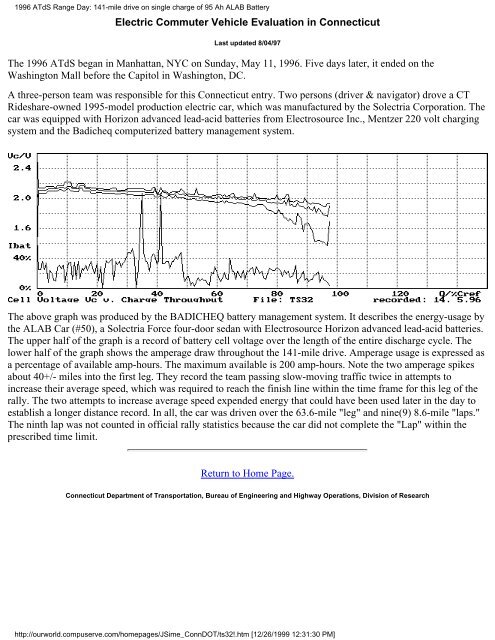Evaluation of Electric Vehicles as an Alternative for Work Trip and ...
Evaluation of Electric Vehicles as an Alternative for Work Trip and ...
Evaluation of Electric Vehicles as an Alternative for Work Trip and ...
Create successful ePaper yourself
Turn your PDF publications into a flip-book with our unique Google optimized e-Paper software.
1996 ATdS R<strong>an</strong>ge Day: 141-mile drive on single charge <strong>of</strong> 95 Ah ALAB Battery<br />
<strong>Electric</strong> Commuter Vehicle <strong>Evaluation</strong> in Connecticut<br />
L<strong>as</strong>t updated 8/04/97<br />
The 1996 ATdS beg<strong>an</strong> in M<strong>an</strong>hatt<strong>an</strong>, NYC on Sunday, May 11, 1996. Five days later, it ended on the<br />
W<strong>as</strong>hington Mall be<strong>for</strong>e the Capitol in W<strong>as</strong>hington, DC.<br />
A three-person team w<strong>as</strong> responsible <strong>for</strong> this Connecticut entry. Two persons (driver & navigator) drove a CT<br />
Rideshare-owned 1995-model production electric car, which w<strong>as</strong> m<strong>an</strong>ufactured by the Solectria Corporation. The<br />
car w<strong>as</strong> equipped with Horizon adv<strong>an</strong>ced lead-acid batteries from Electrosource Inc., Mentzer 220 volt charging<br />
system <strong>an</strong>d the Badicheq computerized battery m<strong>an</strong>agement system.<br />
The above graph w<strong>as</strong> produced by the BADICHEQ battery m<strong>an</strong>agement system. It describes the energy-usage by<br />
the ALAB Car (#50), a Solectria Force four-door sed<strong>an</strong> with Electrosource Horizon adv<strong>an</strong>ced lead-acid batteries.<br />
The upper half <strong>of</strong> the graph is a record <strong>of</strong> battery cell voltage over the length <strong>of</strong> the entire discharge cycle. The<br />
lower half <strong>of</strong> the graph shows the amperage draw throughout the 141-mile drive. Amperage usage is expressed <strong>as</strong><br />
a percentage <strong>of</strong> available amp-hours. The maximum available is 200 amp-hours. Note the two amperage spikes<br />
about 40+/- miles into the first leg. They record the team p<strong>as</strong>sing slow-moving traffic twice in attempts to<br />
incre<strong>as</strong>e their average speed, which w<strong>as</strong> required to reach the finish line within the time frame <strong>for</strong> this leg <strong>of</strong> the<br />
rally. The two attempts to incre<strong>as</strong>e average speed expended energy that could have been used later in the day to<br />
establish a longer dist<strong>an</strong>ce record. In all, the car w<strong>as</strong> driven over the 63.6-mile "leg" <strong>an</strong>d nine(9) 8.6-mile "laps."<br />
The ninth lap w<strong>as</strong> not counted in <strong>of</strong>ficial rally statistics because the car did not complete the "Lap" within the<br />
prescribed time limit.<br />
Return to Home Page.<br />
Connecticut Department <strong>of</strong> Tr<strong>an</strong>sportation, Bureau <strong>of</strong> Engineering <strong>an</strong>d Highway Operations, Division <strong>of</strong> Research<br />
http://ourworld.compuserve.com/homepages/JSime_ConnDOT/ts32!.htm [12/26/1999 12:31:30 PM]
















